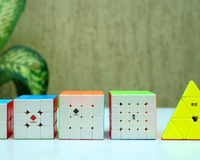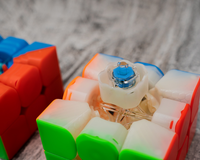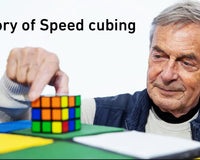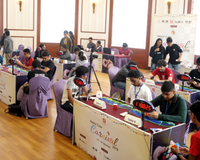OLL and PLL Made Simple: The Key to Faster CFOP Solves
When using the CFOP method to solve a Rubik’s Cube, two of the most important steps for improving your speed are OLL (Orientation of the Last Layer) and PLL (Permutation of the Last Layer). These steps determine how efficiently you can solve the last layer, significantly impacting your overall solve time. Learning them properly can take your solving skills to the next level.
Read until the end to also learn how to quickly learn these algorithms using 5 simple steps.
OLL: Orientation of the Last Layer
OLL is the penultimate step of solving the Rubik’s Cube using the CFOP method. At this stage, all pieces of the last layer are in their correct positions, but their orientations may be incorrect. The goal of OLL is to get all last-layer pieces facing the right way so that the top face becomes a solid color.

There are two ways to approach OLL: 2-Look OLL and Full OLL. The best way to learn is to start with 2-Look OLL, which is a stepping stone to learning Full OLL over time.
2-Look OLL
As the name suggests, this is a 2-step method. First, you form a cross on the last layer, using a short algorithm (usually yellow if you started with a white cross). Then, you use one of a few algorithms to solve the remaining pieces. This significantly reduces the number of algorithms you need to learn compared to Full OLL.
You can learn this step, including the algorithms, using this video.
Full OLL
This method requires learning 57 different cases, each with its own algorithm. Mastering Full OLL allows you to solve the last layer's orientation in just one algorithm, making your solves much faster.

At first, 57 cases might seem overwhelming, but you can break them down into smaller, more manageable groups based on their shapes. Many speedcubers categorize OLL cases into blocks, lightning bolts, and other common patterns, making them easier to recognize and memorize. By following a structured approach, you can learn Full OLL in as little as three weeks.
On this website, you can find all 57 OLL cases sorted by shape, along with multiple algorithm options for each.
PLL: Permutation of the Last Layer
PLL is the final step in solving the Rubik’s Cube using the CFOP method. This step ensures that all last-layer pieces are correctly positioned, fully solving the cube.
Just like OLL, there are two ways to approach PLL: 2-Look PLL and Full PLL. If you’re still working on improving your solving skills, 2-Look PLL is a great way to get started before transitioning to Full PLL.
2-Look PLL
2-Look PLL is a simplified version of this step, where you solve the last layer in two stages. First, you correctly position the corners using one of two algorithms. Then, you solve the edges using one of four algorithms. This method requires learning only 6 algorithms in total, making it much more manageable for beginners.
You can learn 2-Look PLL using this video.
Full PLL
Full PLL allows you to solve the last layer in one step using one of 21 possible algorithms. This eliminates the need for two separate algorithms, making your solves faster and more efficient.
Learning full PLL is much easier than learning full OLL. Not only is 21 algorithms a more manageable number, but also 6 of those algorithms are already included in 2-look PLL. This leaves you with only 15 new algorithms to learn to finish this step.
If you take a structured approach, you can learn Full PLL in less than two weeks. A good way to practice is by drilling individual cases and focusing on finger tricks to improve execution speed.
You can find a full list of 21 PLL cases, categorized by type, along with multiple algorithm options on this website.
Thoughts on Learning New Algorithms

The best way to learn OLL and PLL algorithms is the drilling method. Here is how it goes:
1. Set up the case and take a good look at it. Mentally note down how you would recognize this case in your solves.
2. Solve the case using your chosen algorithm.
3. Now, on a solved cube, keep doing the algorithm over and over, until you are confident that you don’t need to read the notation anymore.
4. Continue doing the algorithm over and over without looking at the notation until you feel it is settled in your muscle memory.
5. In case you forget the algorithm during a timed solve, stop, come back to the algorithm, follow the steps given above again, and then continue with your timed solves.
Conclusion
Mastering OLL and PLL is essential for anyone looking to get faster at solving the Rubik’s Cube using the CFOP method. If you’re just starting, begin with 2-Look OLL and 2-Look PLL, and once you’re comfortable, transition to Full OLL and Full PLL. With consistent practice, recognizing and executing these algorithms will become second nature, helping you improve your solve times significantly.
Happy cubing!






























